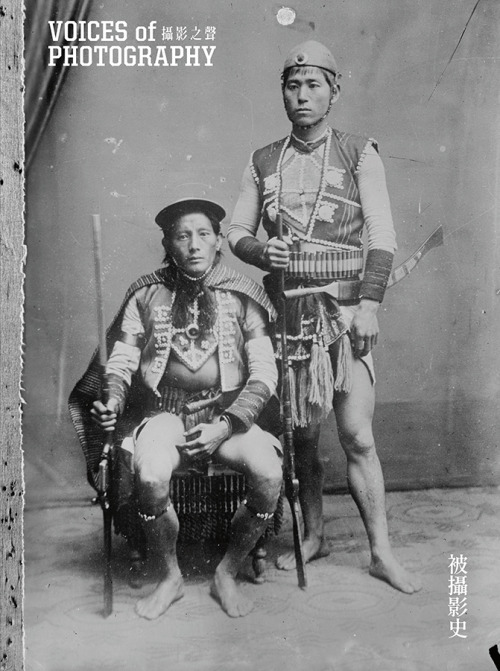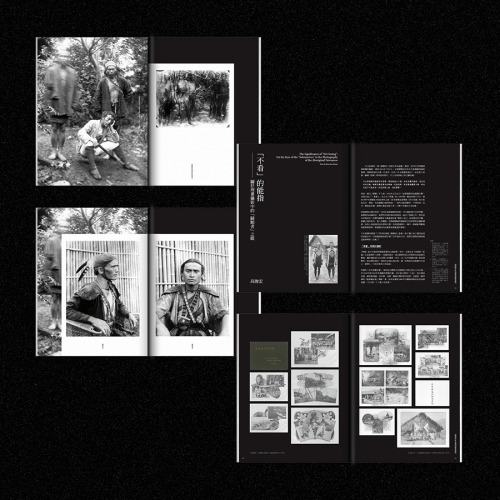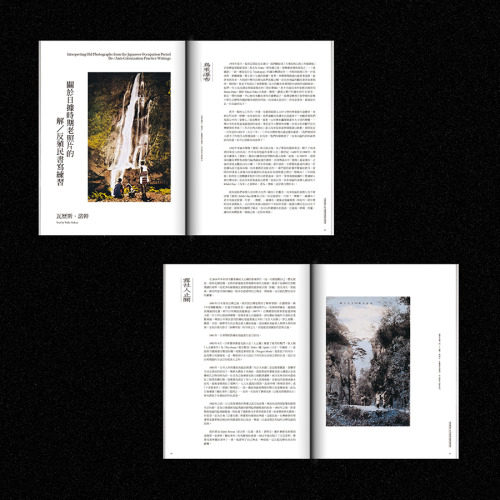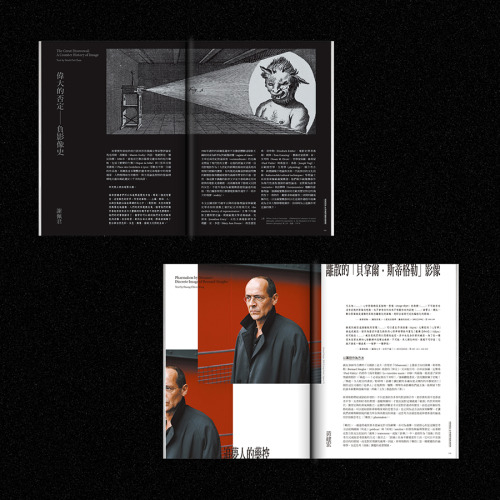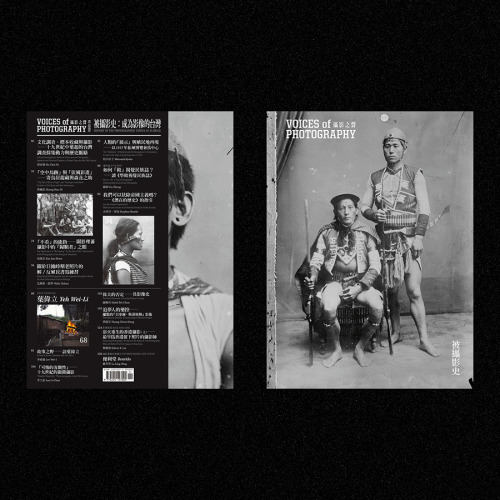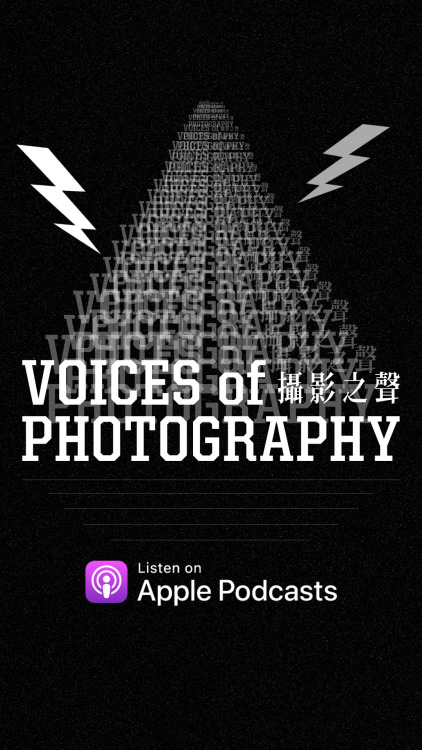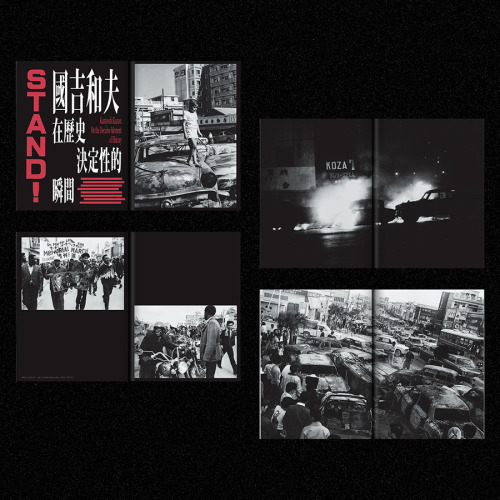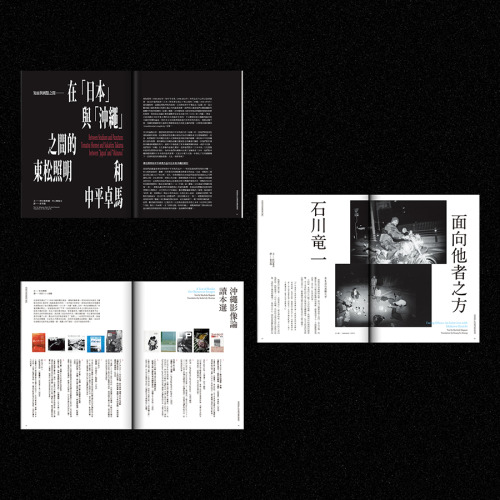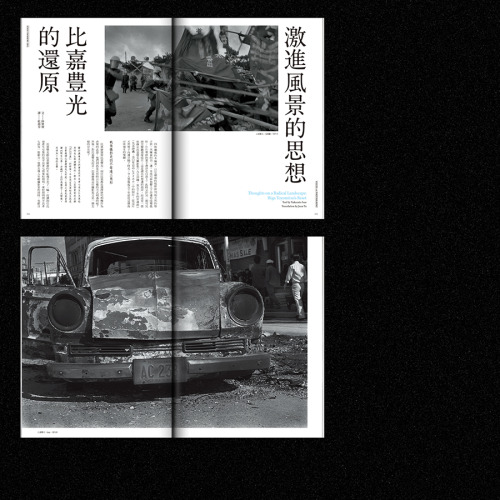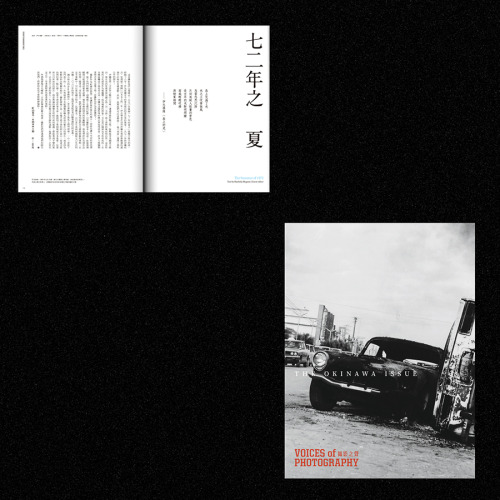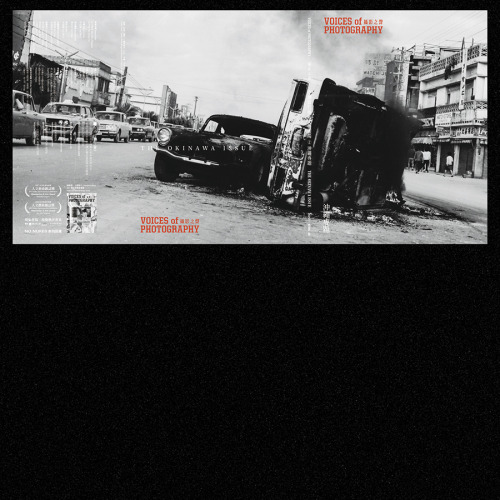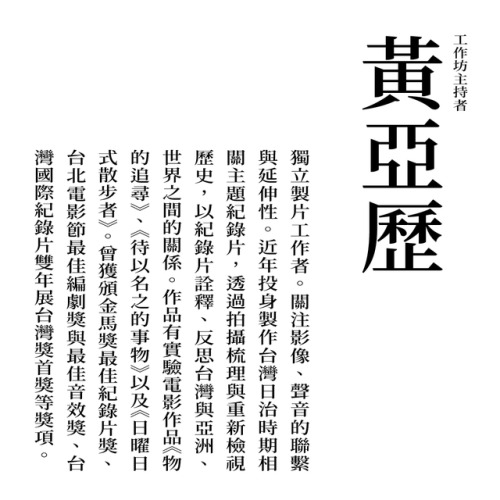#攝影之聲
Voices of Photography 攝影之聲
Issue 29 : 被攝影史──成為影像的台灣
History of the Photographed: Taiwan as an Image
延續我們對於攝影史的關注,本期審視屬於我們自身的攝影經驗──被攝影的歷史。從台灣的殖民史出發,自十九世紀中葉以降歷經的人類學調查採集、二十世紀初隘勇線推進下的暴力顯影,到帝國博覽會裡的「台灣」意象與人種展示──這是一段最為系統性地將台灣影像化的初始時期。我們如何成為被攝影的對象?如何化為一具科學標本和一幅想像圖騰?如何在視覺上被納編(或排除)於國族與文化的整頓編程,並糾結至今?此一影像的潛歷史──被攝影的歷史──是我們返視「攝影史」的一處起點。
藉此,本期試圖反詰「歷史」,思考致使我們「成為影像」、「進入攝影史」的支配與佈局,嘗試突破以往「攝影(者)的歷史」框架,開啟我們的「被攝影(者)的歷史」覺察,或許將能發現對我們而言更為重要的攝影的歷史遺產,生成屬於我們的另翼影像史觀。
專題中收錄的影像與文論,標記了我們在「被攝影」的歷史經驗裡的複雜和衝突──我們從已故人類學者胡家瑜對早年台灣人類學田野調查至戰後發展的介紹專論開始,探看影像採集的知識化歷程及當代意涵;黃翰荻追尋日本人類學者鳥居龍藏與森丑之助在殖民年代的台灣原住民族群踏查足印,細述二人巨大的歷史身影;高俊宏在總督府「理蕃時期」的諸多「討伐」寫真帖中,重新諦視「歸順者」肖像裡的幽微目光;瓦歷斯.諾幹以解/反殖民書寫,展現自身與族人生命經驗裡實切的影像歷史感知;松田京子則以東京拓殖博覽會中對殖民地的活人陳列展演,析解形塑「台灣」的視覺策略。
本期Artist’s Showcase單元,我們與藝術家葉偉立進行長篇訪談,呈現他這些年來以行動介入所構成的獨特影像場域,記錄其未曾間斷的勞作沉思。而在影像論述單元,本期新闢由影像研究者李立鈞執筆的科學攝影專欄,揭示平時隱沒在科學實踐中的「影像問題」,首篇從圖繪細菌與拍攝細菌在十九世紀引發的論爭談起,一探科學家對於攝影「客觀性」的認知辯證。謝佩君接續前期對於影像/視覺理論的引介,深入闡論歐美學界近年如何反駁過去以視覺機具作為現代性發展的線性觀點。黎健強探究香港攝影源流的連載系列,揭載「作為影像的香港」在1850年代末首次出現於可供西方觀眾賞玩的遠東立體照片。此外本期亦特邀黃建宏撰文紀念近期辭世的法國哲學家貝拿爾.斯蒂格勒,記述其影像哲理綿延的技術與時間之論。
在本期出版(焦頭爛額)之際,也正是《攝影之聲》邁入第十年的開端,回想起來真是一段不可思議的旅程。感謝所有的讀者共同撐起這份小刊,也要再次感謝參與《攝影之聲》、支持我們的朋友與工作伙伴,給予我們面對艱困的勇氣,繼續在蜿蜒的道路上行進。
_____________
購書 Order
台灣讀者免運費優惠中!
_____________
As we continue on the topic of the history of photography, we turn to our own photography experiences in this issue – our history of being photographed. It takes root in Taiwan’s colonial history, from the collection of anthropological surveys in the 19th century, to the acts of violence at the defence lines as they pushed on during the Japanese colonial era in the early 20th century, as well as the exhibition of the “Taiwanese” imagery and ethnicity at various expositions held during the Japanese colonial rule. These form the beginnings of a systematic effort to visualize Taiwan. How did we become the photographed, a scientific specimen, a totemic image? How did we become visually part of (or excluded from) the rectification process of nationality and culture, that continues to trouble us till now? The veiled history of such an image – the history of being photographed – guides the beginning of our journey of looking back at the “history of photography”.
With this, we attempt to cross-examine “history” and think through the control and disposition that led us into “becoming an imagery” and “going into the history of photography”, hoping to break free from the existing framework of “the history of the photograph(er)” and enlighten our awareness of the “history of the photographed”. We reckon this could allow us to discover the historical heritage of photography that is even more important to us and generate our very own alternative view of the history of photography.
The collection of imagery and essays in this series marks the complexity and conflicts in our historical experience of “being photographed”. We begin with the late anthropologist Hu Chia-Yu’s field research of Taiwan’s anthropology from the early years to the post-war period as we explore the knowledge-based development and contemporary meaning of imagery collection. Huang Han-Di traces the footsteps of Japanese anthropologists Torii Ryuzo and Mori Ushinosuke in their study of the Taiwanese indigenous peoples in the colonial era, detailing the historical impact that they had. Kao Jun-Honn takes a second look at the faint gaze in the eyes of those who had pledged allegiance, as captured in the many portraits of the “submissives” kept at the Governor-General’s office during the Japanese rule. Walis Nokan expresses his and his fellow people’s real perception of the history of photography as they had experienced it in his de-/anti-colonization writings. Matsuda Kyoko analyses the visual strategy of shaping “Taiwan” through the living displays at the Tokyo Colonization Exposition of 1912.
In this issue’s “Artist’s Showcase”, we feature an in-depth interview with artist Yeh Wei-Li, showing our readers his unique field of imagery that extends from his art of intervention, a record of his neverending contemplation with regard to labor and art. Moving on to essays on visual imagery, we present a new scientific photography column by imagery researcher Lee Li-Chun, who unveils the “imagery problem” that underlies scientific practice, beginning with cognitive dialectics of “objectivity” of photography by scientists that stemmed from the debate sparked by illustrating and photographing bacteria in the 19th century. Hsieh Pei-Chun continues with her introduction to imagery/visual theory from an earlier issue, and explains in detail how Western academia has refuted the existing linear view of visual machinery as a modern development. Edwin K. Lai’s series on the origins and development of Hong Kong photography tells us about the first 3D photograph from the Far East that aimed to entertain a Western audience with “Hong Kong as an image” in the late 1850s. In addition, we specially invited Huang Chien-Hung to commemorate the French philosopher Bernard Stiegler, who had recently passed, and the continuous techniques and time that stems from his philosophy of imagery.
At the same time as we (run off our feet to) prepare for the publication of this issue, Voices of Photography is going into its 10th year, and what an incredible journey it has been. We sincerely thank all our readers for keeping us going, and express our heartfelt gratitude once again to all our friends and partners who have worked with us and given us the courage to overcome our difficulties to march on on this winding road.
_____________
更多訊息 More info
www.vopmagazine.com
Post link
《攝影之聲》Podcast首播上線
錄好一集製播生疏聲線緊張的pppooooodcast (結巴) ! 初次試音,請多指教~~~
《攝影之聲》的首次播音,我們與人在新加坡的客座主編許芳慈越洋連線,一起聊聊本期「沖繩專題」的編輯過程,並在沖繩「Koza暴動」將屆五十周年之際,討論關於沖繩的歷史觀察與影像論。
首播現於Spotify放送,近期也將在Apple Podcasts上線。歡迎空中相會。
((( 收聽 Listen )))
Post link
Voices of Photography 攝影之聲
Issue 28 : 沖繩專題
The Okinawa Issue
「亞洲當代攝影文化現場系列」是我們聚焦亞洲各地影像文化與創作實踐的系列計畫,嘗試透過亞際跨域連結與在地論述視野,拓展我們對於攝影在亞洲的實踐歷程、視覺經驗、文化及其論域的認識座標,並藉此作為影像歷史與認識論的持續省思。
「沖繩專題」是此系列的第二輯,特別邀請影像研究者暨策展人町田惠美與許芳慈共同擔任客座主編。本期採雙向閱讀編輯,集結文論與訪談,穿越沖繩糾結的被殖民史與帝國陰霾,在霸權的支配和抵抗的鬥爭之間,批判地觀看沖繩的影像,以及作為影像的沖繩。
幾世紀前,位於太平洋上的琉球列島尚未成為「沖繩」,而是存在著一個封建君主制的國度——琉球王國,後經日本薩摩藩的島津氏入侵與大日本帝國擴張,廢琉設藩遭到併吞殖民,於1879年以「沖繩縣」編入日本國家體系之內。在二戰的尾聲、1945年激烈的沖繩島戰役後,美國的佔領統治期長達二十七年,沖繩從此劃進冷戰年代的軍事戰略島鏈。即使至1972年美國將沖繩「返還」日本,在「日美同盟」的交換條件下,僅為日本本土面積千分之六的沖繩,卻佈建了整體駐日美軍逾七成的軍事設施與基地。對某部分的沖繩來說,「戰後」彷彿被無限延長,使這個亞熱帶之島,彌漫著由地緣政治與新帝國主義擊燃而仍未散去的煙硝。
本專題介紹國吉和夫、石川真生、比嘉豐光與石川龍一等沖繩的影像實踐者,追索他們的生命經驗與攝影的多重構成,以及其間複雜的政治性問題意識;同時透過評論者仲里效、岡本由希子、仲宗根香織與井上間從文的專文,將影像之於沖繩、之於歷史,由慣常對於「如何再現」的注意力,置放於「如何建構」的維度。從而提示了影像不僅僅是從殖民的情境中派生,同時也反饋到殖民的情境裡,需要加以細緻地解析。
在專題的製作期間,由全球疫情激化的國際角力波濤洶湧。與沖繩同列第一島鏈的台灣等地讀者,閱讀本專題,或許會因類似的歷史背景與政治局勢處境而更能與沖繩共感。而在沖繩所帶來的種種啟示中,我們也將意識到對於當下的世界正在發生的反抗——無論是以國家主義修辭掩飾的極權主義和種族主義,或是以經濟復甦為號召的資本主義巨靈回魂,除非我們投入更多行動與關注,否則任何國家的「強國夢」,都會是人類史上的惡夢一場。
The “A Study of Contemporary Photography in Asia” series is a serial project that focuses on imagery culture and creative practice in various regions of Asia. Through this connection and a view that pans across Asia, we are trying to expand our understanding of the process of practice, visual experience, culture and the identifying coordinates of photography in Asia, and using such knowledge as a continuous reflection of imagery history and epistemology.
Second in the series is the Okinawa issue that features Machida Megumi and Hsu Fang-Tze, both imagery researchers and curators, as our guest editors. This issue adopts a dual reading and editing process; a combination of essays and interviews brings readers through the complicated colonial history and the burden of empiricism on the island, taking a critical view of Okinawa’s imagery, and Okinawa as an imagined object while it struggled against hegemony.
Several centuries ago, there existed no “Okinawa”, but the Ryukyu Kingdom, a feudal kingdom in the Ryukyu Islands in the Pacific Ocean. After the invasion by the forces of the feudal domain of Satsuma, and subsequently by the Empire of Japan, the Ryukyu Islands were annexed and colonized, and in 1879, established as the Okinawa Prefecture. At the end of the Second World War in 1945, the U.S. forces occupied and ruled Okinawa for 27 years, sealing its fate in the strategic chain of islands in the Cold War era. Even when the U.S. forces “returned” Okinawa to Japan in 1972, the island, which only constitutes 0.6% of Japan’s total land area, houses more than 70% of the U.S.’s military facilities and bases stationed in the whole country under the US-Japan Security Alliance. To some parts of Okinawa, it almost feels like that the “post-war” era never ended, surrounding this subtropical island with a plume of smoke that rose from the collision between geopolitics and new imperialism.
In this series, we take a look at the layered composition of the life experiences and photography by Okinawan imagery practitioners Kuniyoshi Kazuo, Ishikawa Mao, Higa Toyomitsu and Ishikawa Ryuichi, as well as the complicated political consciousness that is birthed from this interaction. We also move our focus from the question of “how to represent” to “how to construct” the background of Okinawa and its history through the essays by Nakazato Isao, Okamoto Yukiko, Nakasone Kaori and Inoue Mayumo. Through such a redirection of focus, we see the need for a careful analysis as it shows us that imagery is not only generated from colonization, but also feeds back into the issue.
While putting this issue together, the world is being ravaged by the COVID-19 pandemic, intensifying power rivalries. We imagine that our readers in Taiwan and other areas, which belong in the first island chain alongside Okinawa, would feel even more relevance to the island (Okinawa), given our similar histories and political situations. As we feel inspired by Okinawa in many ways, we also become aware of the struggles that are happening around the world, whether it is one against totalitarianism and racism under the mask of nationalistic rhetoric, or the return of capitalism in the name of economic recovery. Until we put into action our words and resist, any dream of a “nation of great power” is but a nightmare for the history of humankind.
.回饋雜誌訂戶,凡有效訂戶隨刊附贈限量海報一張!
.現在於VOP Bookshop購買新刊的前50位讀者也將獲得海報喔!隨刊寄出,贈完為止!
Post link
Voices of Photography 攝影之聲
Issue 27 : 歷史與書寫專題
Histories and Writings Issue
自創刊以來,《攝影之聲》持續關注影像書寫、歷史與文化樣態,隨著2019年我們在台北「空總台灣當代文化實驗場」策劃一系列攝影史敘事工作坊並舉辦戰後東亞攝影史論壇,邀請攝影史研究者共同參與,推進攝影史研究與影像歷史意識的討論契機。本期特別刊載主講者文稿,在日本、韓國與台灣研究者對東亞攝影歷程不同的關注面向中,作為攝影與歷史論述的反思與參照。
其中,金子隆一重新定位1970年代攝影家自主藝廊在日本攝影發展中的位置,揭示非主流的創作脈動,何以是日本攝影史論中需要補遺的重要章節;陳佳琦探討1960年代台灣業餘攝影者參與日本攝影比賽的風潮,以及以日本攝影雜誌作為平台的競賽文化的可能影響,呈現出戰後台、日攝影界另類的民間交流場域;朴平鍾細述自日本殖民統治結束後,韓國攝影在現實主義與現代主義之間引發的論爭,疏理戰後韓國對於攝影認知的辯證與反省;戶田昌子析論1950年代的日本攝影表現,在脫離戰時的壓抑並逐漸獲得解放之後,受國際「主觀主義攝影」潮流影響所開展出日本攝影美學進程的時代軌印;張世倫從冷戰年代深埋於台灣社會的檔案線索與政治意識,檢視戰後台灣的影像操縱、治理機制,以及國族攝影史本身的建構和詮釋問題。
攝影,在與光學、化學、政治社會學、文化研究,乃至符號學與精神分析等學科譜系的結合中,已不斷延展、流動、重構,打開了攝影本體論的探索空間。謝佩君縷析自上世紀以來的攝影書寫歷程與跨領域的視覺理論,勾勒攝影理路的發展形貌,本期將開啟系列討論的首章。顧錚分享於德國海德堡大學客座期間開設攝影史課程的自身經驗,並提出攝影史學門研究邊界的批判思索。黎健強剖析攝影術初登香港的歷史推論系列來到末篇,為濕版法在1850年代於香港興起的考據,展現不同的史料論證。
此外,本期我們特別專訪陳傳興,刊載他於上世紀七〇年代末拍攝、四十年間未曾公開的照片及底片,一探銀鹽與光交集而生的影像喻意,以及他不停思辨的攝影本質論題。同時,我們也介紹高重黎的聲音與投影裝置新作,析解視聽機器現成物及獨特的一鏡到底、史上最長的「放影機電影」中的技術哲學。「攝影書製作現場」連載則進入「設計」單元,本期專訪日本設計師森大志郎,分享他細膩的平面設計語彙。
儘管維持出版的路途艱辛,這些年我們仍努力在有限的資源下,持續進行資料考掘整理、訪談記錄等基礎工作,緩緩開展以台灣及亞洲地緣為核心的攝影文化與歷史論述。感謝親愛的讀者與朋友的支持,讓我們在新的一年裡,繼續探索未知的影像星河。
購買 | Buy
Since its inception, Voices of Photography has always focused on the aspects of image writing, history and cultural forms. In 2019, we held a series of workshops on photography history narratives and a forum on history of post-war East Asian photography, at the Taiwan Contemporary Culture Lab in Taipei, Taiwan. We invited researchers in this field to join us, creating the opportunity to advance discussions on photography history research and awareness of imagery history. This issue features the manuscripts of our speakers at the event, which will serve as a reflection and reference for the photography and historical discourse in the eyes of our counterparts in Japan, South Korea and Taiwan.
Among them, Kaneko Ryuchi has redefined the position of independent photography galleries in the development of Japanese photography in the 1970s, revealing the creative pulses that transcended the mainstream and why it became an important chapter in the history of Japanese photography, waiting to be filled. Chen Chia-Chi takes a look at the trend of Taiwanese amateur photographers participating in photography contests in Japan in the 1960s, and the possible influence that Japanese photography magazines had on the culture of photo competition, thereby shedding light on an alternative platform through which folk exchanges happened between the Taiwanese and Japanese photography fields. Park Pyungjong details the controversy between realism and modernism in Korean photography following the end of colonial rule by the Japanese, and evaluates the dialectics and reflections surrounding Korea’s understanding of photography after the war. Toda Masako analyzes Japanese photography in the 1950s, the era of Japanese photographic aesthetics that was influenced by the trend of “subjectivism” in the international arena as the oppression of war gradually faded in time. Through archives and political consciousness buried deep in the core of the Taiwanese society since the Cold War era, Chang Shih-Lun examines the manipulation and governance mechanism of images, and issues with the construction and interpretation of the nationality in photography history.
When analyzed in combination with other disciplines such as optics, chemistry, political sociology, cultural studies, and even semiotics and psychoanalysis, the space for exploration of the ontology of photography is constantly stretched, moved, and reconstructed. Hsieh Pei-Chun analyzes the photographic writing process and the cross-domain visual theory since the last century while outlining the development of photography theories. This issue is the first in a series of discussions. Gu Zheng shares his own experience as a visiting professor on photography history at the University of Heidelberg, Germany, where he put forward a critical reflection on the boundaries of research in the field of photography history. Edwin K. Lai’s analysis of the series of historical inferences from when photography first came to Hong Kong comes to an end, presenting historical evidence of the rise of the “wet-plate method” in Hong Kong in the 1850s.
In addition, we have a special interview with Cheng Tsun-Shing, featuring never-before-published photographs and negatives that he had taken in the late 1970s. We explore the imagery metaphors that are born when silver salt and light meet, and the issue of the essence of photography that he constantly philosophizes. At the same time, we feature Kao Chung-Li’s new works of sound and projection installations, analyzing the ready-made audio-visual equipment and the technical philosophy behind the unique one-take “projector movie”, that is also the longest ever such film in history. The “Photobook Making Case Study” series also enters the “Design” chapter. In this issue, we interview Japanese designer Mori Daishiro and he shares his experiences in the area of graphic design.
Although the journey of publication is difficult, we have been striving to continue with the basics of data exploration, collation, and interviews with limited resources, as we slowly expand the photography culture and historical discourses of Taiwan and Asia and showcase them to the world. We would like to thank all our dear readers and friends for your utmost support. Let us continue to explore the unknown universe of images in the new year.
Post link
黃亞歷 | 生活偽像:「聲音眼」及其悖謬工作坊
【請點此報名】電影,構築在聲音與視覺的關係之中,此關係也同時對於聲音及視覺提出了分歧或逆反的視角。當我們以電影為基底觸及影像敘事時,聲音扮演何種位置?電影是聲音藝術嗎?聲音是獨立存在於電影中的嗎?或者聲音是視覺的一部分?聲音與視覺在電影中提出了技巧的思辨或概念的實踐?聲音是電影再現真實的媒介嗎?當聲音在電影裡發生時,真實與現實如何被感知?當聲音在電影裡空缺時,真實與現實是否能夠被感知?歷史與真實/現實之間,電影聲音提出了什麼探索點或可能性?
在電影視覺和聲音的經驗中,生活形生變貌,岔裂出縫隙,因而,視聽的感知狀態成為歷史詮釋的一處起點。
時間 | 2019/11/09(六)、 2019/11/10(日),每日14:00至17:00
地點 | 空總C-LAB「CREATORS空間102共享吧」(台北市大安區建國南路一段177號)
關於歷史後像:攝影史敘事工作坊系列
今年最後一個工作坊啦,限額20名,別錯過囉 !
Post link
攝影史敘事.亞洲論域系列論壇:戰後東亞攝影史
Narratives of Photography History.Asia Discourse Forum Series:
The History of Post-war East Asian Photography
由《攝影之聲》策畫並與空總臺灣當代文化實驗場共同主辦的「攝影史敘事.亞洲論域系列論壇」,關注台灣與亞洲的攝影史當前研究,聚焦探討攝影在亞洲的發展軌跡、攝影史的當代意義,以及攝影史論的創造性敘事,藉由對亞際地緣與歷史連帶的多元思索,作為理解台灣與亞洲攝影史的參照,同時建立跨國際的研究觀點、經驗及資源的交流。
本次論壇從戰後的東亞攝影發展節點出發,邀請日本、韓國與台灣的攝影史研究者共同參與,透過多面向的歷史架構與研究書寫策略,針對亞洲攝影在戰後的發展歷程與文化現象進行專題發表與對話討論,同時對「什麼是攝影史」以及攝影史方法論提出反身性思辨。
(本活動為自由入場,座位有限,歡迎參加!)
This series of forums takes a look at current research into the history of photography in Taiwan and Asia, focusing on the development trajectory of photography in Asia, the contemporary significance of the history of photography, and the creative narrative perspective of the historical treatise on photography. A multifaceted reflection of the interregional geographic and historical links serves as an expanded reference in the understanding of photography history in Taiwan and Asia. At the same time, the forum will facilitate the establishment of international exchanges on research perspectives, experiences and resources.
These forums will begin with the post-war development of photography in East Asia. Guest speakers from Japan, South Korea and Taiwan will share their research, done through a multi-faceted historical framework and research writing strategies, and talk about the development process and cultural phenomena of Asian photography in the post-war era. They will also put forward their reflexive speculations on “what is the history of photography” and the methodology of research in photography history.
詳情 More
Post link



::::: VOP新據點 NEW STOCKIST ALERT :::::
飛地.Nowhere|台北市萬華區中華路一段170-2號1樓
嚟西門町新開幕嘅飛地書店睇書✨
請多支持!

歡迎光臨讀字便利店!VOP專櫃上架✨
讀字便利店在台北松菸開張,2月9日至2月14日,每天11點至晚上8點,眾獨立出版陣線全員出動,備妥新春書食,不打烊等您,祝開讀大吉!
_________________
2022讀字公民書展——讀字便利店
地點|台北松山文創園區2號倉庫
時間|2/9 ~ 2/14,11am~8pm

祝大家虎年順心如意、平安健康~
Voices of Photography 攝影之聲

休閒.品茗.讀書.談天.觀星
歲末,小社再度參加一年一度的牯嶺街市集擺書攤,今年很少機會外出,在年終的最後一個假期裡期盼能多和讀者交流,歡迎大家來串門子。現場可以找到各期雜誌書刊、私房攝影書、私房海報、私房小物,同時提供私房優惠,還有很多讚讚的私房攤友,精銳盡出,請一定要來市集尋寶呀。
牯嶺街書香創意市集 Guling Street Book & Mart
日期 Dates | 12/25(Sat.) 10:00-20:00, 12/26 (Sun.) 10:00-17:00
地點 Venue | 台北市牯嶺街 Guling Street, Taipei
「攝影之聲」 攤位編號S4




出版兩個月後的《現實的探求──台灣攝影史形構考》今天早晨進行再刷工作,期待很快能將新書交給更多讀者。
_____________
張世倫 《現實的探求──台灣攝影史形構考》
Reclaiming Reality:
On the Historical Formation of Taiwanese Photography
by CHANG Shih-Lun
本書集結影像史研究者張世倫近十年來的攝影史研究書寫,重返檔案文獻與歷史事件,以批判性的目光,帶領讀者細細觀察攝影在台灣歷史中的蜿蜒流動,反思「攝影史」的形構歷程。
所謂的「攝影史」究竟如何建構?如何變化?如何可能?攝影在台灣的實踐與想像,形成了什麼樣的「攝影史」?
作為攝影史論著,本書獨到之處,正是敏銳地提出「#台灣攝影史」構造本身的問題意識,以文化研究的觀點,藉由踏查攝影在台灣歷史中的開展,細膩地審視歷史形構的細節,呈現出攝影史敘事多樣而複雜的潛在空間──「複數」的攝影史。
本書論及的影像文獻與歷史場景十分廣博多元,從十九世紀至二十世紀早期的攝影檔案、圖像繪葉書、寫真帖,乃至風景攝影、俗民攝影、證件照與政治宣傳,探究影像與現實的關聯;同時重訪沙龍攝影、現代主義思潮、紀實攝影與當代攝影裝置在台灣的發展,以及《劇場》、《ECHO》和《人間》等文化刊物時代的關鍵影響,重現台灣影像實踐開拓的各式路徑,並在此歷史書寫中,將它們轉化為與當下的我們息息相關的視覺文化思索。
本書將是關切台灣攝影與視覺文化發展、不停追問攝影與歷史的我們,重新思考「台灣攝影史」的一次重要契機。

